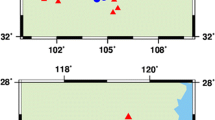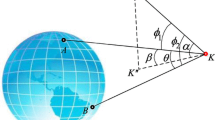Abstract
Although integer ambiguity resolution (IAR) can improve positioning accuracy considerably and shorten the convergence time of precise point positioning (PPP), it requires an initialization time of over 30 min. With the full operation of GLONASS globally and BDS in the Asia–Pacific region, it is necessary to assess the PPP–IAR performance by simultaneous fixing of GPS, GLONASS, and BDS ambiguities. This study proposed a GPS + GLONASS + BDS combined PPP–IAR strategy and processed PPP–IAR kinematically and statically using one week of data collected at 20 static stations. The undifferenced wide- and narrow-lane fractional cycle biases for GPS, GLONASS, and BDS were estimated using a regional network, and undifferenced PPP ambiguity resolution was performed to assess the contribution of multi-GNSSs. Generally, over 99% of a posteriori residuals of wide-lane ambiguities were within ±0.25 cycles for both GPS and BDS, while the value was 91.5% for GLONASS. Over 96% of narrow-lane residuals were within ±0.15 cycles for GPS, GLONASS, and BDS. For kinematic PPP with a 10-min observation time, only 16.2% of all cases could be fixed with GPS alone. However, adding GLONASS improved the percentage considerably to 75.9%, and it reached 90.0% when using GPS + GLONASS + BDS. Not all epochs could be fixed with a correct set of ambiguities; therefore, we defined the ratio of the number of epochs with correctly fixed ambiguities to the number of all fixed epochs as the correct fixing rate (CFR). Because partial ambiguity fixing was used, when more than five ambiguities were fixed correctly, we considered the epoch correctly fixed. For the small ratio criteria of 2.0, the CFR improved considerably from 51.7% for GPS alone, to 98.3% when using GPS + GLONASS + BDS combined solutions.














Similar content being viewed by others
References
Al-Shaery A, Zhang S, Rizos C (2013) An enhanced calibration method of GLONASS inter-channel bias for GNSS RTK. GPS Solut 17(2):165–173
Bisnath S, Gao Y (2009) Current state of precise point positioning and future prospects and limitations. In: Sideris MG (ed) Observing our changing earth. Springer, Berlin, pp 615–623
Chuang S, Wenting Y, Weiwei S, Yidong L, Rui Z (2013) GLONASS pseudorange inter-channel biases and their effects on combined GPS/GLONASS precise point positioning. GPS Solut 17(4):439–451
Collins P, Lahaye F, Héroux P, Bisnath S (2008) Precise point positioning with AR using the decoupled clock model. In: Proceedings of ION GNSS 2008, 16–19 September, Institute of Navigation, Savannah, pp 1315–1322
Estey LH, Meertens CM (1999) TEQC: the multi-purpose Toolkit for GPS/GLONASS data. GPS Solut 3:42–49
Euler HJ, Schaffrin B (1991) On a measure for the discernibility between different ambiguity solutions in the static-kinematic GPS-mode. In: IAG Symposia no. 107, kinematic systems in geodesy, surveying, and remote sensing, Springer, New York, pp 285–295
Gabor MJ, Nerem RS (1999) GPS carrier phase AR using satellite-satellite single difference. In: Proceedings of ION GPS 1999, 14–17 September, Institute of Navigation, Nashville, pp 1569–1578
Ge M, Gendt G, Rothacher M, Shi C, Liu J (2008) Resolution of GPS carrier phase ambiguities in precise point positioning (PPP) with daily observations. J Geod 82(7):389–399
Geng J, Shi C (2017) Rapid initialization of real-time PPP by resolving undifferenced GPS and GLONASS ambiguities simultaneously. J Geod 91(4):361–374
Geng J, Meng X, Dodson A, Teferle F (2010a) Integer ambiguity resolution in precise point positioning: method comparison. J Geod 84(9):569–581
Geng J, Meng X, Dodson AH, Ge MR, Teferle FN (2010b) Rapid reconvergence to ambiguity-fixed solutions in precise point positioning. J Geod 84(12):705–714
Geng J, Teferle FN, Meng X, Dodson AH (2011) Towards PPP-RTK: ambiguity resolution in real-time precise point positioning. Adv Space Res 47(10):1664–1673
Hatch R (1982) The synergism of GPS code and carrier measurements. In: Proceedings of the third international symposium on satellite Doppler positioning at Physical Sciences Laboratory of New Mexico State University, Feb 8–12, vol 2, pp 1213–1231
Jokinen A, Feng S, Schuster W, Ochieng W, Hide C, Moore T, Hill C (2013) GLONASS aided GPS ambiguity fixed precise point positioning. J Navig 66(3):399–416
Kouba J, Héroux P (2001) Precise point positioning using IGS orbit and clock products. GPS Solut 5(2):12–28. doi:10.1007/PL00012883
Laurichesse D, Mercier F (2007) Integer ambiguity resolution on undifferenced GPS phase measurements and its application to PPP. In: Proceedings of International Technical Meeting of the Satellite Division of the Institute of Navigation 839–848
Laurichesse D, Mercier F, Berthias JP, Broca P, Cerri L (2009) Integer ambiguity resolution on undifferenced GPS phase measurements and its application to PPP and satellite precise orbit determination. Navigation 56(2):135–149
Leick A, Rapoport L, Tatarnikov D (2015) GPS satellite surveying, 4th edn. Wiley, Hoboken
Li X, Zhang X (2012) Improving the estimation of uncalibrated fractional phase offsets for PPP ambiguity resolution. Navigation 65(3):513–529
Li P, Zhang X (2014) Integrating GPS and GLONASS to accelerate convergence and initialization times of precise point positioning. GPS Solut 18(3):461–471
Liu Y, Ye S, Song W, Lou Y, Chen D (2016a) Integrating GPS and BDS to shorten the initialization time for ambiguity-fixed PPP. GPS Solut. doi:10.1007/s10291-016-0525-1
Liu Y, Song W, Lou Y, Ye S, Zhang R (2016b) Glonass phase bias estimation and its ppp ambiguity resolution using homogeneous receivers. GPS Solut. doi:10.1007/s10291-016-0529-x
Liu Y, Ye S, Song W, Lou Y, Gu S (2017) Rapid PPP ambiguity resolution using GPS + GLONASS observations. J Geod 91(4):441–455
Melbourne WG (1985) The case for ranging in GPS-based geodetic systems. In: Proceedings of the first international symposium on precise positioning with the global positioning system, Rockville, 15–19 April
Pratt M, Burke B, Misra P (1998) Single-epoch integer ambiguity resolution with GPS-GLONASS L1-L2 Data. In: Proceedings of ION GNSS 1998, September 15–18, Institute of Navigation, Nashville, pp 389–398
Reussner N, Wanninger L (2011) GLONASS inter-frequency biases and their effects on RTK and PPP carrier phase ambiguity resolution. In: Proceedings of ION GNSS 2011, September 19–23, Institute of Navigation, Portland, pp 712–716
Shi J, Gao Y (2014) A comparison of three PPP integer ambiguity resolution methods. GPS Solut 18(4):519–528
Teunissen PJG (1994) A new method for fast carrier phase ambiguity estimation. In: Proceedings of IEEE position, location and navigation symposium, Las Vegas, pp 562–573
Teunissen PJG, Khodabandeh A (2014) Review and principles of PPP-RTK methods. J Geod 89(3):217–240
Verhagen S, Teunissen PJG (2013) The ratio test for future GNSS ambiguity resolution. GPS solut 17(4):535–548
Wang J, Rizos C, Stewart MP, Leick A (2001) GPS and GLONASS integration: modeling and ambiguity resolution issues. GPS Solut 5(1):55–64
Wanninger L (2012) Carrier phase inter-frequency biases of GLONASS receivers. J Geod 86(2):139–148
Wanninger L, Beer S (2015) BeiDou satellite-induced code pseudorange variations: diagnosis and therapy. GPS Solut 19(4):639–648
Wu JT, Wu SC, Hajj GA, Bertiger WI, Lichten SM (1993) Effects of antenna orientation on GPS carrier phase. Manuscr Geod 18:91–98
Wübbena G (1985) Software developments for geodetic positioning with GPS using TI-4100 code and carrier measurements. In: Proceedings of the first international symposium on precise positioning with the global positioning system, Rockville, April
Yamada H, Takasu T, Kubo N, Yasuda A (2010) Evaluation and calibration of receiver inter-channel biases for RTK-GPS/GLONASS. In: Proceedings of ION GNSS 2010, September 21–24, Institute of Navigation, Portland, pp 1580–1587
Zumberge JF, Heflin MB, Jefferson DC, Watkins MM, Webb FH (1997) Precise point positioning for the efficient and robust analysis of GPS data from large networks. J Geophy Res 102(B3):5005–5017
Acknowledgements
We are grateful to the anonymous reviewers and the editor for their constructive suggestions. This work is partially supported by the National Key Research and Development Program of China (Nos. 2016YFB0501802, 2016YFB0502203), National Natural Science Foundation of China (Nos. 41074008, 41374034, 41404010, 41301511, 41604028, 41604017, 41401444), National 973 Program of China (No. 2012CB957701), Shenzhen future industry development funding program (No. 201507211219247860), Shenzhen Scientific Research and Development Funding Program (No. JCYJ20140418095735587).
Author information
Authors and Affiliations
Corresponding author
Rights and permissions
About this article
Cite this article
Liu, Y., Lou, Y., Ye, S. et al. Assessment of PPP integer ambiguity resolution using GPS, GLONASS and BeiDou (IGSO, MEO) constellations. GPS Solut 21, 1647–1659 (2017). https://doi.org/10.1007/s10291-017-0641-6
Received:
Accepted:
Published:
Issue Date:
DOI: https://doi.org/10.1007/s10291-017-0641-6




